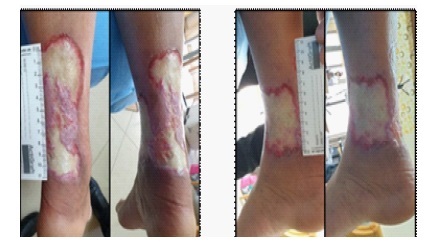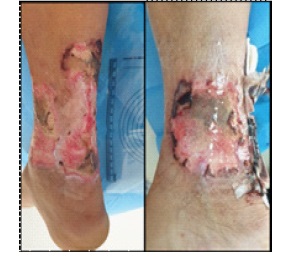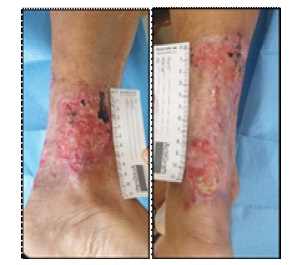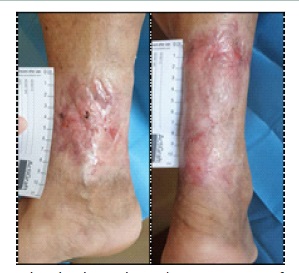
Journal of Clinical Images and Medical Case Reports
ISSN 2766-7820
Case Report - Open Access, Volume 3
Chronic venus ulcer pain reduction and full recovery by an autologous blood clot: A case study
Elena Dimitriou
Wound Management and Tissue Viability Nurse, (West Midlands, UK) Graft-In International, Limassol, Cyprus.
*Corresponding Author: Elena Dimitriou
Wound Management and Tissue Viability Nurse,
(West Midlands, UK) Graft-In International, Limassol, Cyprus.
Email: demelena888@gmail.com
Received : Feb 01, 2022
Accepted : Feb 25, 2022
Published : Mar 04, 2022
Archived : www.jcimcr.org
Copyright : © Dimitriou E (2022).
Abstract
Introduction: Venous Leg Ulcers (VLU) can be associated with severe pain, having a tremendous effect on the ulcer treatment and eventually the patient’s quality of life. Dressing removal and procedures are the main cause for VLU pain, however, background pain is common in chronic wounds, with numerous patients needing analgesics to manage the pain.
ActiGraft is an autologous whole blood clot, created by the patient’s own peripheral blood, at a point of care to treat cutaneous wounds. ActiGraft mimics the Extracellular Matrix (ECM) by creating a protective scaffold, that promotes the acceleration of the wound healing process.
Case study: We here by describe a case study of a 63-year-old patient who exhibits a 1-year-old VLU, that went under advanced treatments previously with no improvement. This was the result of the deterioration of a simple scratch that extended to a spreading wound, covering a large area of the shin. The patient experienced high pain levels and consumed large amounts of analgesics during the past year of his life, with no significant relief. The patient suffered severe pain and was unable to sleep for more than a 3 hour period, every single night.
ActiGraft weekly application was able to change the pain form during the first treatment and followingly reduce the pain levels with a constant decrease in wound pain with every application. ActiGraft treatment was able to promote the healing process, achieving a complete wound healing after receiving 16 weeks of constant treatment.
Discussion: Pain associated with VLU has a major effect on the patient’s quality of life and can significantly impact the ability to efficiently treat the ulcer. ActiGraft treatment progressed the wound toward complete healing and reduced the pain level from the wound, suggested to have an anti-inflammatory effect, which contributes to the reduction of pain levels and initiating the natural wound healing process.
Conclusion: ActiGraft was found to have a significant effect in reducing wound pain levels, having an impact on the patient’s quality of life, and also progressing hard-to-heal wounds toward complete healing. This synergetic effect establishes ActiGraft as an effective wound healing product in patients with multiple comorbidities, who are suffering from severe background pain related to their wound.
Keywords: VLU; autologous blood clot; pain.
Citation: Dimitriou E. Chronic venus ulcer pain reduction and full recovery by an autologous blood clot: A case study. J Clin Images Med Case Rep. 2022; 3(3): 1714.
Introduction
Venous ulcers (VLU) are a common problem in the elderly population, account for 80% of the lower extremity ulceration [1]. The patient’s past medical history related to obesity, previous lower limb injuries, deep vein thrombosis, and phlebitis, appear to have a primary role in the risk of developing VLU [2]. VLU is the most common type of ulcer directly associated with pain, manifesting an immense impact on the patient’s quality of life, that contributes to a deteriorate or even negative wound healing process [3]. The underlying pathology of VLUs is the cause of the background pain that patients experience, causing the procedural or operative treatment being sore, along with skin irritation [4]. Pain can be classified as acute, chronic, nociceptive, or neuropathic with patients often experiencing a combination of multiple types of pain, which makes it harder to resolve [5].
Wound dressing and particularly the dressing removal procedure is one of the main causes of VLU pain. It has been observed that a great part of the patients’ population needs painkiller support in order to cope with the pain they experience, during the wound dressing process [6]. Moreover, an aggressive dressing removal can potentially damage the delicate healing tissue, emphasizing the importance of the appropriate dressing selection, a dressing that promotes moisture at the wound and peri-wound area, in order to prevent a traumatic dressing removal [7].
Moisture balance, debridement, and bacterial balance/controlled inflammation are important to VLU management. The pain associated with performing procedures, such as frequent dressing changes in order to control moisture and wound bacteria, as well as surgical, enzymatic, or mechanical debridement, appear to have a significant effect on the pain associated with the ulcer. As a result, the wound treatment decelerates due to the fact that patients experience centralized soreness to the wound or extended to the rest of the limb, which tends to worsen post-dressing change commencement [8].
ActiGraft, an autologous whole blood clot created from the patient’s own peripheral blood, acts as a protective scaffold and mimics the Extracellular Matrix (ECM) properties. ActiGraft was found to be creating a moisture balance to the wound area, by achieving an optimal pH with stable levels between 7.2 and 7.6. Therefore it was presented to be promoting epithelialization, by mediating the proliferation of the tissue keratinocytes and fibroblasts [9].
Moreover, a topical applied autologous blood clot was found to significantly reduce the bacterial bioburden; a crucial factor of inflammation control [10].
In this case study, ActiGraft’s characteristics associated with pain management and wound healing accelerated process, are discussed.
Case study
A 63-year-old male with a 1-year VLU on the left shin, presented several comorbidities, amongst others diabetes, hypertension, and hypercholesterolemia. The patient was also diagnosed with kidney cyst and skin sensitivity, both conditions were under supervision only, and the skin sensitivity had no added impact on the ulcer. The patient also suffered from atherosclerotic lesions and multiple local stenoses on the affected limb. The patient’s medications were included insulin treatment for the diabetes condition and antibiotic ointments, wound antiseptic sprays, and creams with or with no Silver for the wound care treatment. The patient was suffering from intense wound pain and was using opioid and non-opioid painkillers multiple times a day, for instant pain relief of the left limb.
The ulcer developed due to a small scratch located on the left shin (2 X 2 cm) and kept spreading throughout the treatments followed, over a 1 year period. The ulcer deterioration lead the patient to experience severe pain intensity, to the extent that the opioid analgesics were unable to reduce the suffering for no more than 3 hours. Local anesthetic creams and a variety of antiseptic ointments used also provided minimal effect on pain management.
Further treatments the ulcer underwent over the year, included surgical debridement every 2-3 months and Ozone therapy combined with negative pressure wound therapy, which unfortunately lead to significant deterioration of the ulcer, by increasing the wound dimensions that was spreading not only at the front but additionally to the inner side of the patients’ shin. The almost catastrophic result added stress to the patient and affected his daily routine. The severe pain had an effect on the patient’s quality of life in many aspects. The patient suffered from a severe lack of sleep due to the pain, ended up using a walking cane, and was unable to drive his car, for more than 5 months due to the excessive pain he was under.
The pain affected his ability to work and maintain his daily routine which had a crucial effect on the patient’s mental health. The wound at that point reached the size of 90 cm2 (Figure 1).
ActiGraft application was introduced to the wound on a weekly basis for 15 weeks. Prior to the ActiGraft application, the pain had spread out not only at the wound and peri-wound area but outspread to the whole limb. Post to the first application, the patient kept experiencing the same amount of pain for the first 3 days. During the first week, the patient noticed a positive change in the pain he experienced, and by the end of the 2nd ActiGraft application, he described a limitation of the pain, locally to the wound area only (Figure 2). Following this drastic improvement, the patient’s mental health revived, and gained back his independence; he no longer needed the walking aid and he was able to go back to driving. The painkiller consumption was also reduced and by the 5th treatment, the patient stopped using opioids for pain relief.
Good wound debridement is vital, prior to the ActiGraft application, in order to achieve the best potential result, in the least time possible. Due to the fact that the debridement procedure was extremely painful-considering the bad state the wound came to – the patient was advised to receive a strong analgesic 1 hour prior to our appointment, in order to minimize the suffering. By the 8th treatment he only needed paracetamol twice daily to cope with minor pain spikes, and by the 10th week, he needed no painkillers at all.
Throughout the weeks, the patient reported an extraordinary improvement of his quality of life, becoming able of returning to his occupation duty and personal obligations, and additionally was able to sleep through the night without experiencing pain. Along with the pain improvement, a 60% healing process was observed to the wound in the first 5 weeks of treatment (Figure 3). The wound achieved a complete healing post the 15th ActiGraft application (Figure 4).
Discussion
Pain associated with VLU can implicate the patient’s quality of life, affecting also the ability to treat the ulcer in an efficacious way. Patients experiencing excessive pain levels are unwilling or unable to comply with the necessary treatment, and a delay in wound healing is often observed [11]. 80% of the patients with VLUs are reporting on a wound-related background pain, having a mild to moderate pain intensity on average, with almost half of them (37%) experiencing severe pain levels [12- 13]. When the wound care procedures cause a high pain intensity, this may lead to incomplete wound debridement or cleansing, increasing the risk of its infection and delayed healing. It was found that high pain increases the stress levels, resulting in a reduction of proinflammatory cytokines of the wound environment, which are essentials in clearing debris and infection control. These pro-inflammatory cytokines occupy a crucial role in pain signals and stress response [14]. When the wound is infected, wound-related bacteria can release metalloproteases and inflammatory mediators which lead to tissue damage and direct stimulation of pain receptors [15]. Moreover, imprudentpain also activates the sympathetic branch of the autonomic nervous system, triggering a physiological response that slows wound healing [16].
In this case study, ActiGraft was introduced to a painful VLU, after excluding various treatments of regular and advanced wound healing procedures, not only with no progression but with significant deterioration of the wound associated with the implementation of the patient’s anxiety. The relationship between wound pain and anxiety was investigated intensively, pointing out that the levels of stress and anxiety from a single pain episode, change nociceptive pain pathways and elevate anticipatory pain, establishing future potential procedures, even excessively painful [17]. The pain had a severe impact on the patient’s quality of life, increasing the need for analgesics in high doses in order to control the pain level, but with no significant relief. The patient’s daily routine and lifestylewere affected, including mental health, financial issues, going to work, and driving, due to the extensive pain he experienced.
Following the first ActiGraft applications, the ulcer’s pain level reduced significantly, providing direct relief to the patient. The immediate positive effect of the ActiGraft’s application indicates that ActiGraft has anti-inflammatory properties, contributing to the reduction in pain levels, such as accelerated wound healing. An autologous whole blood clot was suggested to have an effect on macrophages in the wound environment. Macrophages play a vital role in wound healing by managing the inflammatory response, growth factors release, phagocytosis, and cellular proliferation. The M1 macrophages produce proinflammatory cytokines important to the initiation of wound healing. When the tissue starts to repair, the M1 pro-inflammatory macrophages are changing to M2 anti-inflammatory, secreting anti-inflammatory cytokines, progressing the wound into the proliferative phase of wound healing. However, in chronic wounds, the M1 macrophages can’t transition to M2 macrophages, leading to further damage. It has been hypothesized that autologous whole blood clot tissue may have the capacity to attenuate the M1 macrophage phenotype in chronic wounds. This effect contributes to the reduction in the inflammatory response and the reduction of pain as a result.
ActiGraft serves as a protective biological scaffold, which creates an optimal environment for wound healing. The autologous whole blood clot is attached to the wound bed and forms itself into the tissue, initiating hemostasis; the first stage of the healing process. The clots act as an ECM that provides not only physical infrastructure but also regulates the cellular activity of the cells in the wound, progressing it from an inflammation phase, to the proliferative phase [10]. Moreover, the autologous whole blood clot tissue can reduce bacterial bioburden, minimizing the risk of wound infection and promoting the acceleration of the healing process.
Conclusion
ActiGraft was found to have an effect in reducing the wound affectionated pain and by progressing the healing process, it eventually improves the patient’s quality of life. ActiGraft, established as a point of care treatment, acts as an ECM protective scaffold, promoting the healing process, promoting the wound from the inflammation to the proliferative phase. It is suggested that those properties also attributes to the effect of ActiGraft on the immune cells, transitioning from pro-inflammatory to antiinflammatory response, resulting in pain reduction.
Pain relief of chronic and painful wounds is an important aspect of the patient’s treatment regimen. Chronic pain impacts the patient’s ability to comply with the treatment, resulting in delayed wound healing, or even deterioration. ActiGraft’s extraordinary effect of progressing the wound towards healing, whilst reducing the pain and promoting the anti-inflammatory action, establishes ActiGraft as an essential wound healing product.
References
- O’Meara S, Al-Kurdi D, Ovington LG. Antibiotics and antiseptics for venous leg ulcers. Cochrane Database Syst Rev. 2008; (1): CD003557.
- Nelson EA, Bell-Syer SE, Cullum NA. Compression for preventing recurrence of venous ulcers. Cochrane Database Syst Rev. 2000; (4): CD002303.
- Sussman C. Preventing and modulating learned wound pain. Ostomy Wound Manage. 2008; 54: 38–47.
- Renner R, Seikowski K, Simon JC. Association of pain level, health and wound status in patients with chronic leg ulcers. Acta DermVenereol. 2014; 94: 50-53.
- Stechmiller JK, Lyon D, Schultz G, Gibson DJ, Weaver MT, Wilkie D, et al. Biobehavioral mechanisms associated with nonhealing wounds and Psychoneurologic symptoms (pain, cognitive dysfunction, fatigue, depression, and anxiety) in older individuals with chronic venous leg ulcers. Biol Res Nurs. 2019; 407-419.
- Price PE, Fagervik-Morton H, Mudge EJ, Beele H, Ruiz JC, Nystrøm TH, et al. Dressing-related pain in patients with chronic wounds: an international patient perspective. Int Wound J. 2008; 5: 159–171.
- Principles of best practice: Minimizing pain at wound dressingrelated procedures. A consensus document. London, UK: MEP Ltd; 2004.
- Bowler PG. Wound pathophysiology, infection and therapeutic options. Ann Med. 2002; 34: 419-427. (Lok C, Paul C, Amblard P, Bessis D, Debure C, Fauvre B, Guillot B, Ortonne JP, Huledal G, Kalis B. EMLA cream as a topical anesthetic for the repeated mechanical debridement of venous leg ulcers: a double-blind, placebo-controlled study. J Am Acad Dermatol. 1999; 40: 208- 213.
- Vallejo L, Achterberg J. Uso de una matrizautólogaeneltratamiento de úlceras de pie diabético, con espectroscopia de infrarrojocercano y medidor de pH dérmico. J Wound Care. 2020; 29: 24-31.
- Snyder RJ, Schultz G, Wachuku C, Rashid AM, Ead JKK, et al. Proposed Mechanism of Action of Topically Applied Autologous Blood Clot Tissue: A Quintessential Cellular and Tissue Based Therapy. Journal of the American Podiatric Medical Association. 2020.
- Fletcher A, Cullum N, Sheldon TA. A systematic review of compression treatment for venous leg ulcers. BMJ. 1997. 315: 576- 580.
- Gardner SE, Blodgett NP, Hillis SL, Borhart E, Malloy L, Abbott L, et al. HI-TENS reduces moderate-to-severe pain associated with most wound care procedures: A pilot study. Biol Res Nurs. 2014; 16: 310-319.
- Leren L, Johansen E, Eide H, Falk RS, Juvet LK, Ljoså TM. Pain in persons with chronic venous leg ulcers: A systematic review and meta-analysis. Int Wound J. 2020; 17: 466-484.
- Fleck CA. Managing wound pain: Today and in the future, Advances in Skin and Wound Care. 2007; 20: 138-145.
- Sibbald GR, Woo K, Ayello E. Increased bacterial burden and infection: NERDS and STONES. Wounds UK. 2007; 3: 25–46.
- Broadbent E, Petrie KJ, Alley PG, Booth RJ. Psychological stress impairs wound repair following surgery. Psychosom Med. 2003; 65: 865–869.
- Woo KY. Meeting the challenges of wound-associated pain: anticipatory pain, anxiety, stress, and wound healing. Ostomy Wound Manage. 2008; 54: 10-12.




